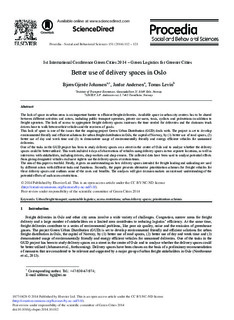| dc.contributor.author | Johansen, Bjørn Gjerde | |
| dc.contributor.author | Andersen, Jardar | |
| dc.contributor.author | Levin, Tomas | |
| dc.date.accessioned | 2019-02-20T07:42:50Z | |
| dc.date.available | 2019-02-20T07:42:50Z | |
| dc.date.created | 2015-02-09T14:09:56Z | |
| dc.date.issued | 2014 | |
| dc.identifier.citation | Procedia - Social and Behavioral Sciences. 2014, 151 112-121. | nb_NO |
| dc.identifier.issn | 1877-0428 | |
| dc.identifier.uri | http://hdl.handle.net/11250/2586394 | |
| dc.description.abstract | The lack of space in urban areas is an important barrier to efficient freight deliveries. Available space in urban city centres has to be shared between different activities and actors, including public transport operators, private car users, taxis, cyclists and pedestrians in addition to freight operators. The lack of access to appropriate freight delivery spaces increases the time needed for deliveries and the distances truck drivers have to walk between their vehicles and the receivers of goods. This lack of space is one of the issues that the ongoing project Green Urban Distribution (GUD) deals with. The project is set to develop environmental friendly and efficient solutions for urban freight distribution in Oslo, the capital of Norway, by (1) better use of road spaces, (2) better use of day and week time and (3) to demonstrate usage of environmentally friendly and energy efficient vehicles for unmanned deliveries. One of the tasks in the GUD project has been to study delivery spaces on a street in the centre of Oslo and to analyse whether the delivery spaces could be better utilised. This work included 6 days of observations of vehicles using delivery spaces in two separate locations, as well as interviews with stakeholders, including drivers, shop workers and shop owners. The collected data have been used to analyse potential effects from giving designated vehicles exclusive right to use the delivery spaces at certain times. The aim of this paper is twofold. Firstly, it gives an understanding on how delivery spaces intended for freight loading and unloading are used by different actors with different tasks and functions. Secondly, the paper presents alternative prioritization schemes for freight vehicles for these delivery spaces and outlines some of the costs and benefits. The analyses will give decision makers an increased understanding of the potential effects of such access restrictions. | nb_NO |
| dc.description.abstract | Better Use of Delivery Spaces in Oslo | nb_NO |
| dc.language.iso | eng | nb_NO |
| dc.relation.uri | http://ac.els-cdn.com/S1877042814054548/1-s2.0-S1877042814054548-main.pdf?_tid=b3be50ac-b130-11e4-b05c-00000aacb362&acdnat=1423578526_1d1670d0b2ea7d8fefe25fca58f97a42 | |
| dc.rights | Attribution-NonCommercial-NoDerivatives 4.0 Internasjonal | * |
| dc.rights.uri | http://creativecommons.org/licenses/by-nc-nd/4.0/deed.no | * |
| dc.title | Better Use of Delivery Spaces in Oslo | nb_NO |
| dc.title.alternative | Better Use of Delivery Spaces in Oslo | nb_NO |
| dc.type | Journal article | nb_NO |
| dc.type | Peer reviewed | nb_NO |
| dc.description.version | publishedVersion | nb_NO |
| dc.source.pagenumber | 112-121 | nb_NO |
| dc.source.volume | 151 | nb_NO |
| dc.source.journal | Procedia - Social and Behavioral Sciences | nb_NO |
| dc.identifier.doi | 10.1016/j.sbspro.2014.10.012 | |
| dc.identifier.cristin | 1219124 | |
| cristin.unitcode | 7401,60,60,0 | |
| cristin.unitname | Transportforskning | |
| cristin.ispublished | true | |
| cristin.fulltext | original | |
| cristin.qualitycode | 1 | |

